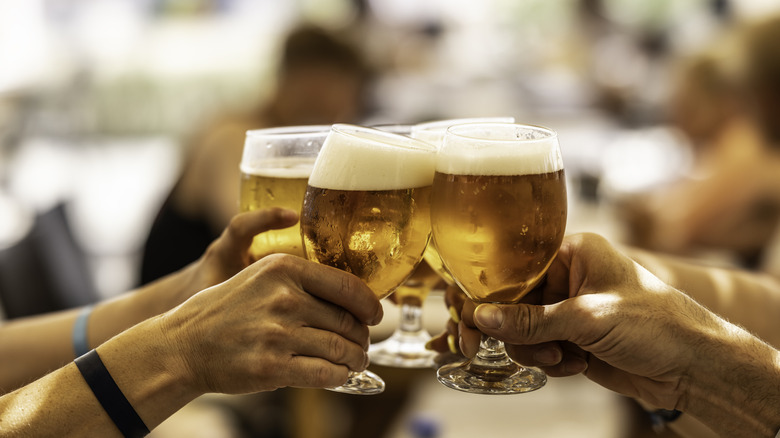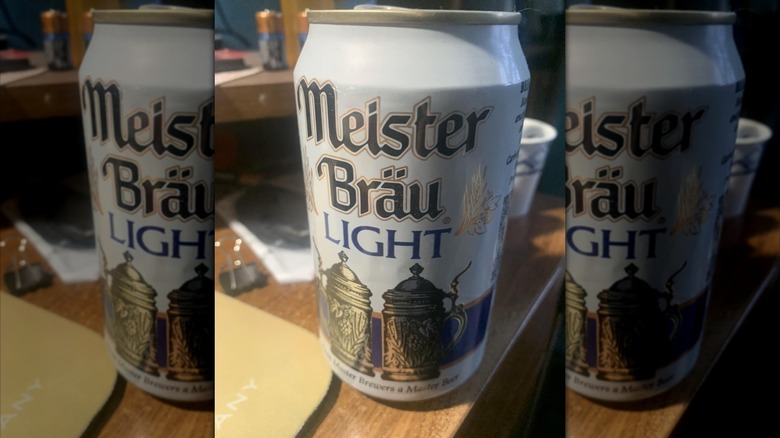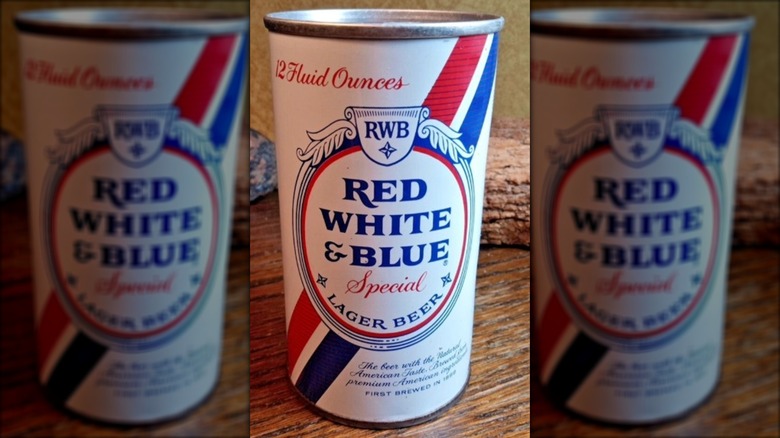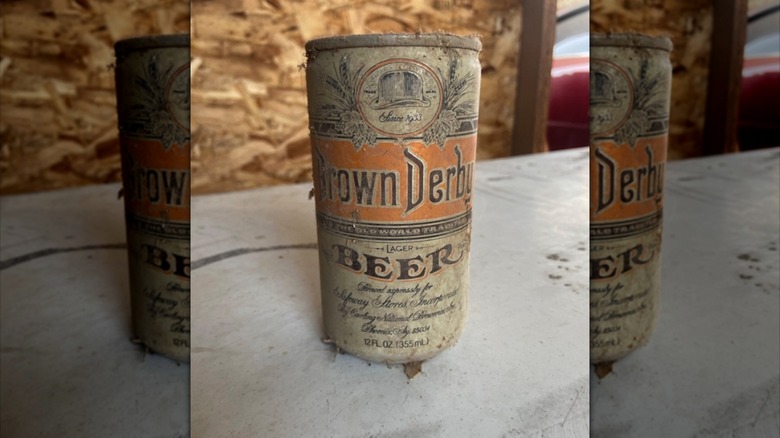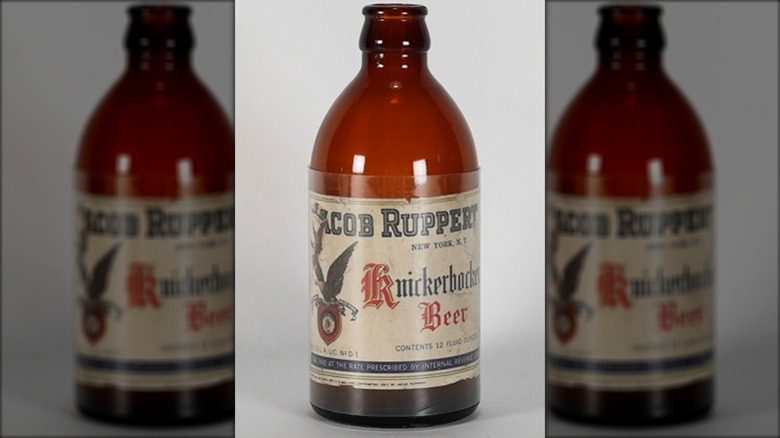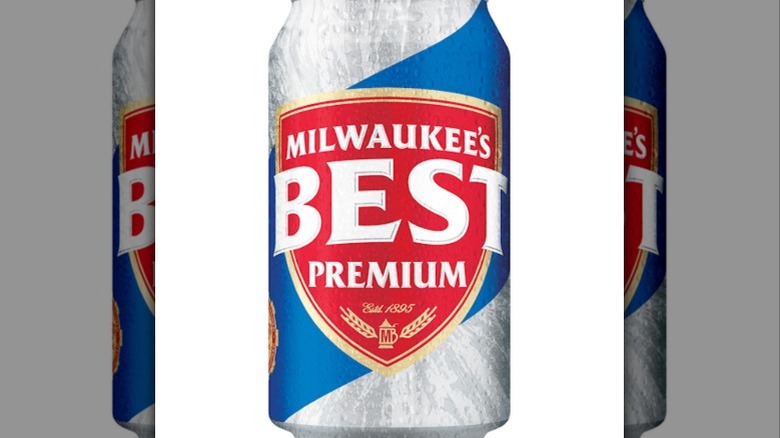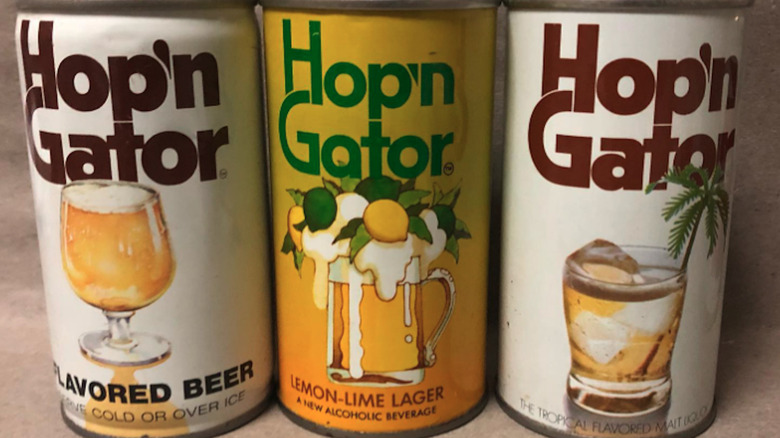10 Old-School Beers That Don't Exist Anymore
We may receive a commission on purchases made from links.
Knocking back a couple of brews is a time-honored tradition. But you may have noticed some brands have vanished from bar taps and convenience store coolers, leaving nothing behind but their legacy. Millennials certainly have a taste for craft beer– and this may well have contributed to the extinction of some of your grandpa's favorite domestic beers.
As this generation reached their 21st birthdays, these artisanal enthusiasts and their purchasing power disrupted the establishment, and once top-selling beer brands silently fell by the wayside. Whether you belong to this group of generational cohorts or not, many of these labels will spark a few beloved memories of your favorite watering hole. Let's give some of the most iconic beers of an age a final toast, as we reminisce about these 10 old-school beers that don't exist anymore.
Falstaff
Falstaff has quite a storied past. This discontinued beer that we're not getting back has changed hands numerous times since it was created by St. Louis-based Western Brewery in 1840. The brand name was sold off to the Griesedieck Beverage Company in 1921 (later renamed the Falstaff Brewing Corporation), and it grew in popularity, reaching top three heights in the United States market by 1960. Just a year later, Albert Schwill's malting facilities took the helm. However, despite the new ownership, Falstaff's sales dipped to 11th place and in 1975, the S&P Company purchased the rights to the brew.
Falstaff was as baseball as peanuts and Cracker Jacks, at least in the early 1970s, when the company moved up to the major leagues with a White Sox sponsorship. Old school baseball fans may still remember commentator Harry Caray shouting, "Man, what I wouldn't give for an ice cold Falstaff right now!" Despite decades of success, S&P Company discontinued Falstaff beer in 2005. Sales had waned to just 1,468 barrels in its final year in distribution, which paled in comparison to its peak production of 7 million barrels in 1966. These low runs were simply unsustainable for the Pabst producer, and another barley pop went extinct.
Meister Bräu Lite
The Meister Bräu brewery was born in Chicago in 1891 as the Peter Hand Brewing Company. The lovechild of Prussian-born brewer Peter Hand changed hands many times over the years. Until 1965, that is, when a group of investors stepped in with a goal to go national with sports team sponsorships, a radio show, and plenty of merch to support its image, and renamed it Meister Bräu. Just two years later, the new owners used a version of brewing legend Joseph Owades' recipe to create its low-calorie brew: Meister Bräu Lite. While it wasn't the best tasting beer on tap, it found success among an unexpected consumer. According to skyrocketing sales figures, blue-collar bar flies just loved it.
While diet beer seemed more like a novelty at the time, it turns out it was a precursor to more successful brands. Miller Brewing Company purchased the failing label in 1972, and through its takeover of the bankrupt brewer, it reformulated the Meister Bräu Lite recipe to create its more beer-like flavored Miller Lite. So, while the original product doesn't exist anymore, with the help of retired athletes and a ton of advertising, Meister Bräu Lite helped boost light beer's popularity to where it reigns today.
Pabst Red White & Blue
Pabst's Red White & Blue's contribution to historically awesome beers is just about as American as it gets. There are a few things you might not know about this popular beer brand's famous offering. It hit markets just in time for the Independence Day holiday back in 1899. From a packaging perspective, it was the only beer you wanted to be seen guzzling on the fourth of July. It was a mellow, drinkable, albeit less potent, version of the brand's flagship pilsner, with an "honest beer for an honest price" catchphrase. You could pick up a sixer of this special lager for just 89 cents back in the '70s, and the '80s recession only helped the company's bottom line.
I don't know if there's a better can of suds for a parched American to reach for than this Pabst offering. So, why did this patriotic brew fall off the map? Red White & Blue production slowed in 1999 and the new generation's taste for beer grew less old-school and more crafty. While the lager was briefly relaunched in 2018 at The Pabst Milwaukee Brewery and Taproom, it's no longer listed on the company's official website. So presumably it's gone forever.
Krueger's Cream Ale
Gottfried Krueger Brewing Company was a true pioneer in the industry. With the help of the American Can Company, the innovator revolutionized beer history with its release of the world's first canned beers. In 1935, Krueger's Cream Ale was introduced to a test market in Richmond, Virginia alongside Krueger's Finest Beer. These 2,000 aficionados actually liked the new product, and with that success, production boomed. This was the first brewer to use the can company's pressurized and specially coated tin vessels to contain its smooth, easy-drinking brew. Post-prohibition consumer response was tremendous, and Krueger took a chunk out of the market shares of giants like Anheuser-Busch and Pabst.
Canned beer, like Krueger's Cream Ale, also came with tons of benefits. Shoppers like that they didn't have to pay a deposit, as they did with bottles. Cans were easy to stack and they reached beer's ideal frosty temperature faster than glass containers. But Krueger's success wouldn't last forever. Industry giants with their mass production capabilities and big budget advertising departments were the company's ultimate downfall. By 1961, the once innovative brewer's vats were empty and it closed its doors for good.
Brown Derby
Brown Derby is a pilsner-type brand that was first bottled in 1933 by the small-time Humboldt Brewing Company. This post-prohibition brew took advantage of Krueger's lead and in 1935 it released its own product in those newfangled cans. Brown Derby's tins debuted wearing a green and brown label with a target audience of at-home imbibers. Consumers could pick it up individually or in a six-pack, something that was groundbreaking during this old-school era.
After a lawsuit brought by the Brown Derby restaurant for branding violations, the beer hit shelves with fresh silver packaging. Just two years later, the California-based brewery earned the spot as the store brand for Safeway and by the mid-50s, distribution expanded across the company's network of supermarkets. When Safeway sold off many of its stores to Vons in 1988, the new owners decided to discontinue the grocer's private-label brew. But its mark on beer history had already been cemented as a prized piece of memorabilia. In fact, a collector shelled out a history-making $93,600 at auction for a vintage can of Brown Derby beer clad in the original infringing artwork.
Knickerbocker Beer
Knickerbocker was the official beer of the New York Giants in the 1950s. That sponsorship likely seemed odd back then, as the beer's brewer, Jacob Ruppert, actually owned the Yankees at the time. That peculiar partnership didn't hold the brand down, although there's some controversy around how it came to be named after a Dutch style of pants. This idiom did transfer nicely to this brand's bottles. After all, it's a New York City thing and the small, Manhattan-based brewery garnered plenty of claim to fame over the years.
The son of German immigrants became one of the Empire State's most prominent brewers, thanks in part to this lager. Ruppert opened his family-owned Uptown brewery in 1913, and in its heyday the operation produced 2 million barrels of beer by the hands of 1,000 workers. It was branded "New York's Favorite" with its filtered water and sterilized beer that delivered its signature "pure" and satisfying flavor. Until it ceased production in 1965. Knickerbocker Beer had a bit of a reprieve when the recipe landed on the desk of Rheingold Breweries' owner, but ultimately the Liebmann family (founders of Rheingold Breweries) discontinued the libation in the 1970s. Just like water under the Brooklyn Bridge, Knickerbocker Beer is gone but not forgotten.
Milwaukee's Best Premium
After an incredibly long 125-year production run, Milwaukee's Best Premium was nixed from Molson Coors' lineup. First made by Gettelman Brewing Company in 1895, this American-style lager became part of the Miller family in 1961 and was then purchased by Molson Coors in 2016. The label was one of 11 economy brands to get the ax by the multinational brewing company in 2021. Gavin Hattersley, CEO, explained, "After an extensive analysis of our business, we are meaningfully streamlining and premiumizing our U.S. portfolio."
Milwaukee's Best Premium was certainly a top quality beer. It was brewed with choice hops and the finest malted barley to produce a beverage that was more than drinkable. It was affordable, too. The label racked up numerous Great American Beer Festival accolades between 2003 and 2005 for its smooth and refreshing taste. Sales tanked between 2007 and 2012 though, down by 58.5 percent, and even silver medals couldn't keep the sun from setting on this old-school beer.
Olympia Beer
A dark cloud descended over the country when Olympia Beer was officially retired in 2020. Leopold Friederich Schmidt created this illustrious old-school beer brand in 1896. The company used only the Deschutes River's artesian spring water in its recipe and boasted an inviting "it's the water" slogan. This German master brewer's complex in Tumwater, Washington paused production for prohibition. But once the dry era ended, the Olympia Brewing Company's operation was back in full swing by 1934 and working out of a brand-new production facility.
Schmidt's company passed to the G. Heileman Brewing Company in 1983 due to an increasing decline in sales. The brewer ditched its historic beer in favor of its award-winning vodka brand in hopes of staying afloat. There was a temporary reprieve for the doomed lager, thanks to a 2024 joint venture between The Country Malt Group, Künstler Brewing, and Olympia Brewing Company. The Olympia Revival Lager was a welcoming tribute to the beer's roots in the Pacific Northwest. What a terrific way to pay homage to this classic American beer.
Billy Beer
Who knew that President Jimmy Carter's younger brother Billy had his own brand of beer? Unless you were born before 1959, the story of POTUS's beer-chugging, gas station-owning sibling may have slipped by you. Billy partnered with Falls City Brewing Company to promote his very own bellywash: Billy Beer. This Kentucky-based brewer had been around since 1905 and even managed to survive prohibition by changing up its product line to near-beers and soda pops. But by 1977, this small, regional company was struggling.
There's no doubt about it. Competing with national beer brands took grit and this isn't the family's peanut farming business. The Billy-endorsed American lager was Falls City's last attempt at winning back some of the market share. The company paid the first brother a whopping $50,000 a year to put his signature on the label and promotion was easy for the suds fan. Downfall seemed inevitable for this failed brand, because, well, it tasted pretty bad. After just a year in production, the brewing company went belly up. That didn't stop collectors from auctioning off unopened cans of Billy Beer in the 1980s, though, and some sixers sold for $1,000. Way to go, Billy!
Hop'n Gator
Hop'n Gator sounds more like a Florida tourist attraction than a beer — but it certainly was a beer. Well, kind of. This can of suds was produced by Gatorade. Yes, that's right. The maker of the electrolyte-enriched sports drink took their turn driving the beer wagon in 1969. The brand became a pioneer in the marketplace with this now-discontinued flavored malt beverage. Although, it careened into a ditch, despite its purported thirst-quenching properties.
Dr. Robert Cade invented the wildly popular rehydrating drink in 1965 with then Florida Gators football coach Dewayne Douglas and the collaborative effort went on to yield an alcoholic version. The alcopop was originally coined Lemon-Lime Lager and it featured a unique combination of energy inducing ingredients, plus beer. Just four years later, Cade sold the recipe to Pennsylvania's Pittsburgh Brewing Company and legal troubles weren't far behind. It turns out, the scientist used University funds to create the beverage. After three years of litigation, the inventor lost 20% of his company, but the brewery persevered, for a while, at least. After a racial allegation-based boycott tarnished Hop'n Gator's reputation forever, sales lost traction, and Hop'n Gator came crashing down in 1975.
